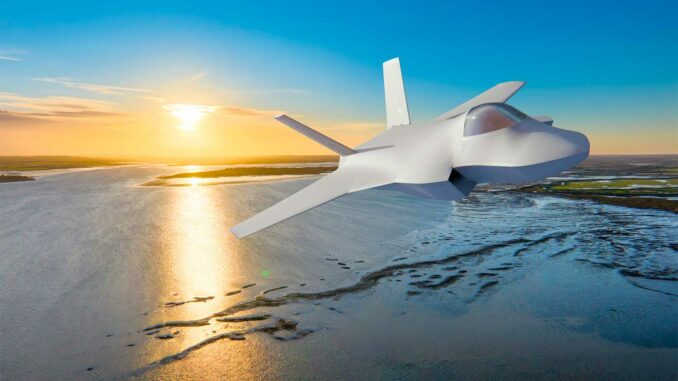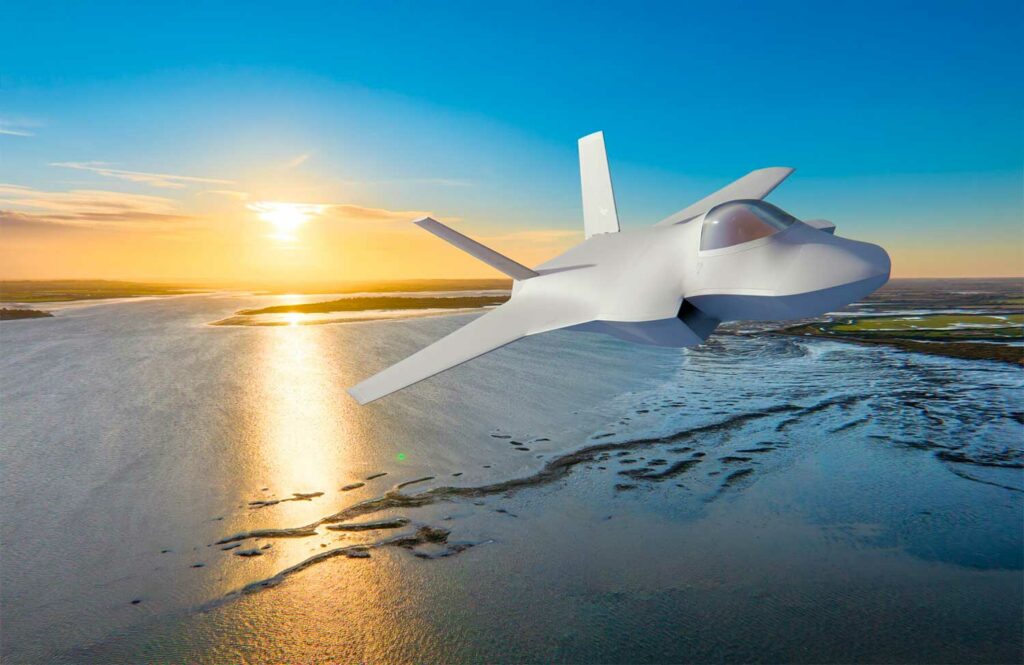
The United Kingdom presents the demonstrator for the Tempest program, the first stealth fighter jet designed in 40 years, with a maiden flight scheduled for 2027.
The Combat Air Flying Demonstrator, the future prototype of the Tempest fighter jet, marks a decisive step in the UK’s air superiority program. Developed by BAE Systems, this aircraft is the first fighter jet design in the UK in four decades. Powered by two EJ200 turbojet engines and incorporating advanced stealth technologies, it is expected to take to the skies by 2027. This demonstrator, built in Warton, serves as a test bed for innovations that will equip the Tempest, which is scheduled to enter service in 2035 with the British, Italian, and Japanese air forces. This ambitious and costly program faces many budgetary and strategic uncertainties, particularly in light of the rise of variants of the F-35.
A demonstrator to prepare the successor to 5th generation fighter aircraft
The Combat Air Flying Demonstrator represents a major technological breakthrough in the British military aviation industry. Designed to validate the technical choices for the future Tempest, this aircraft incorporates some of the features of the F-35, while differing from it in several key respects.
The airframe incorporates diverterless supersonic inlets (DSI) and a twin-engine configuration with outward-sloping tailplanes, but without horizontal stabilizers. This configuration optimizes radar and aerodynamic signature at high speeds. The enlarged fuselage houses two EJ200 engines already used on the Eurofighter Typhoon, providing a combined thrust of over 180 kN, sufficient for high-speed maneuvers while testing the thermal limits of passive stealth.
The absence of horizontal tail surfaces and the adoption of a LERX (Leading Edge Root Extension) delta wing mark an innovative approach to lift and flight control. This solution, derived from studies conducted on configurations such as the F-16U, could offer excellent high-angle stability while integrating radar-discreet surfaces.
The aircraft’s wide nose indicates the likely presence of a large AESA radar, incorporating electronic warfare, data fusion and long-range detection capabilities. The recessed canopy does not appear to be optimized for rear visibility, but meets electromagnetic and aerodynamic stealth requirements.
This demonstrator will play a key role in testing flight dynamics, thermal management, stealth characteristics, and the industrial maturity of the program. Its maiden flight, scheduled for 2027, will be a crucial validation step in moving forward with the final design of the Tempest.
A robotic production line for stealth and modularity
The assembly of the demonstrator at the BAE plant in Warton reflects the UK’s industrialization efforts to produce a modular, automated, and stealth fighter aircraft.
Today, two-thirds of the structural mass of the demonstrator is already in the manufacturing phase. The wings, tail, center fuselage, and front fuselage are being assembled using robotic and digital technologies. This includes the use of:
- Digital twins for mechanical stress design and simulation,
- 3D printing for lightweight structural components,
- Cobots (collaborative robots) for complex assembly stages,
- Model-based system engineering (MBSE),
- Virtual simulation to anticipate in-flight constraints.
These innovations enable shorter production times, full traceability, and rapid reconfiguration in the event of changing military requirements.
The demonstrator also serves as a validation platform for production methods that will be applied to the Tempest. This industrialized approach is crucial to meeting the schedule: flight of the demonstrator in 2027, followed by entry into service of the Tempest in 2035.
The extensive use of these processes reflects a clear objective: to ultimately produce a modular, reliable aircraft incorporating low-radar-signature components, without any dependence on foreign countries. This is in line with the ambition of the GCAP (Global Combat Air Program), in which Italy and Japan are also involved.

An advanced simulator to test flight control laws and control systems
Even before the demonstrator’s first flight, virtual simulator tests are a crucial step in the development of the future aircraft.
Test pilots from BAE Systems, Rolls-Royce and the Royal Air Force have accumulated more than 300 hours of simulated flight time, replicating complex flight conditions, including high-load maneuvers, flight control tests and emergency scenarios.
The simulator includes:
- A physical replica of the cockpit, including the Martin-Baker ejection seat,
- Aerodynamic models coupled with real-time computers,
- Energy management tests, including thermal signature,
- Sensor data fusion tests, to simulate tactical environment perception.
This simulator not only optimizes the onboard systems, but also collects feedback from pilots to adjust the airframe geometry and flight control laws.
At the same time, a Flight Test Aircraft (FTA), based on a modified Boeing 757, has been developed to validate the electronic systems and sensors of the future Tempest in flight. Nicknamed Excalibur, this aircraft will serve as a complementary flying test bed, similar to the role played by the EAP in the Typhoon program in the 1980s.
A race against time and budget constraints
The Tempest program has lofty technical ambitions, but financial and strategic constraints are jeopardizing its viability.
It is scheduled to enter service in 2035, just eight years after the demonstrator’s maiden flight, which is a very short time compared to the Typhoon, which took 17 years between the EAP demonstrator and its entry into service.
This shortening of the timeline is due to the UK’s desire to reduce its dependence on the US and ensure its technological sovereignty, but budgetary realities could decide otherwise.
The UK Ministry of Defense has ordered 12 F-35As with conventional takeoff, in addition to the F-35Bs with short takeoff already in service. The F-35A, which is less expensive (around $90 million per unit compared to more than $120 million for an F-35B) and compatible with nuclear weapons, could prove more attractive on a larger scale.
An extension of this order would represent a direct threat to the Tempest, both in terms of funding and operational justification. In addition, Lockheed Martin is talking about improved versions of the F-35, potentially remotely piloted, with advanced stealth coatings and optimized engines.
At the same time, other major programs, such as the Dreadnought submarine and the replacement of military communications satellites, are competing for budgets.
A strategic platform for trilateral cooperation and air superiority
The GCAP program, which brings together the United Kingdom, Italy, and Japan, is more than just a fighter jet: it is a global combat system, including manned aircraft, drones, smart weapons, communication systems, and data processing centers.
The Tempest will have to:
- Carry twice the payload of the F-35A, potentially up to 8,000 kg of internal munitions,
- Offer extreme autonomy, with internal fuel tanks enabling it to cross the Atlantic without refueling,
- Integrate artificial intelligence technologies, partial autonomy, and communication protocols that are interoperable with NATO.
The GCAP could also reduce unit costs through industrial pooling. The Italian (Leonardo) and Japanese (Mitsubishi Heavy Industries) production lines complement British expertise, with a planned distribution of avionics, sensors, engines, and airframes.
But this cooperation remains fragile. Japan, although heavily involved in the Tempest’s configuration, could reorient its industry according to political choices. Italy, for its part, wishes to maintain its involvement in the Eurofighter program until 2040.
Although an essential step, the British demonstrator does not yet commit the partners to an irreversible schedule. The UK’s ability to secure the Tempest production phase will therefore determine the future of this cooperation.
War Wings Daily is an independant magazine.